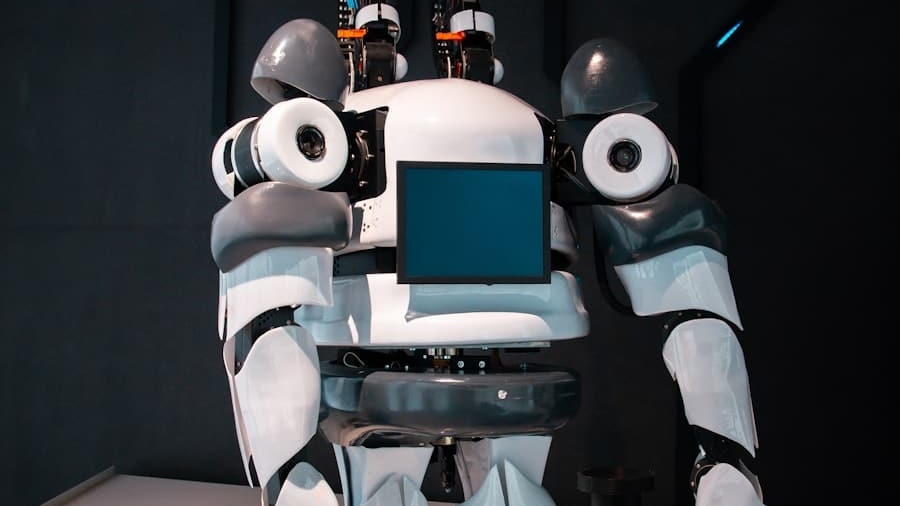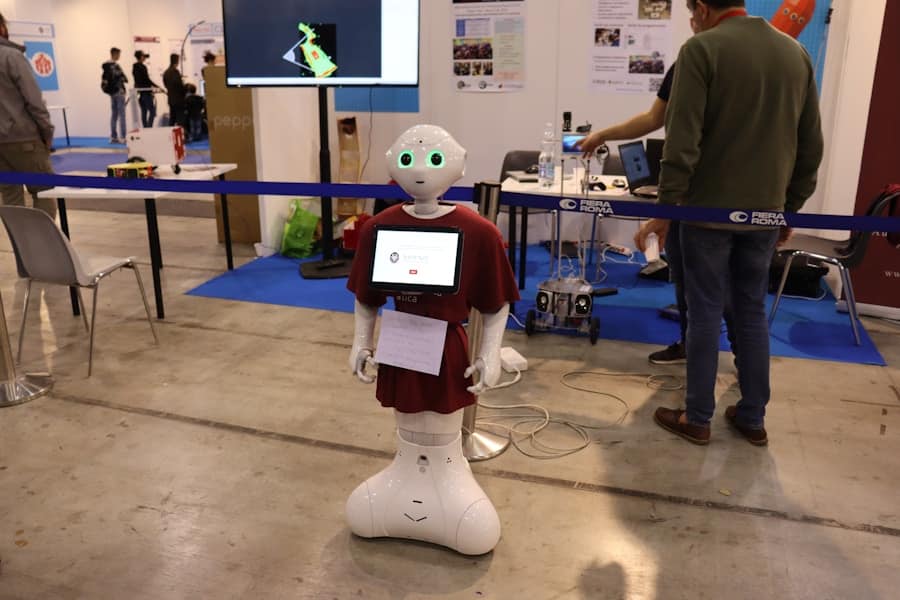Humanoid robotics has emerged as a transformative force in the educational landscape, offering innovative ways to engage students and enhance learning experiences. These robots, designed to mimic human appearance and behavior, serve as interactive tools that can facilitate a variety of educational activities.
Their ability to interact with students in a relatable manner allows for a more personalized learning experience, catering to diverse learning styles and needs. The integration of humanoid robotics into education is not merely a trend; it represents a significant shift in pedagogical approaches. As technology continues to evolve, educators are increasingly recognizing the potential of these robots to bridge gaps in traditional teaching methods.
By providing real-time feedback, engaging students in hands-on activities, and simulating real-world scenarios, humanoid robots can create an immersive learning environment that encourages exploration and curiosity. This article delves into the evolution of artificial intelligence (AI) within humanoid robotics, the benefits and challenges of their implementation in education, and the ethical considerations that arise from their use.
Key Takeaways
- Humanoid robotics in education is an emerging field that has the potential to revolutionize the way students learn and interact with technology.
- The evolution of AI in humanoid robotics has led to the development of more advanced and intelligent robots that can be used for educational purposes.
- Using AI in humanoid robotics for education can provide personalized learning experiences, improve student engagement, and enhance problem-solving skills.
- Implementing AI in humanoid robotics for education comes with challenges such as cost, technical complexity, and the need for specialized training for educators.
- AI plays a crucial role in enhancing learning experiences with humanoid robotics by providing interactive and adaptive learning environments for students.
The Evolution of AI in Humanoid Robotics
From Basic Interaction to Emotional Intelligence
Early models like ASIMO by Honda were primarily designed for mobility and basic interaction, but recent developments have led to robots that can understand context, recognize emotions, and engage in meaningful conversations with users. One notable example of this evolution is the development of Sophia, a social humanoid robot created by Hanson Robotics. Sophia’s ability to engage in conversations and express a range of emotions showcases the potential of AI in creating robots that can interact with humans on a more personal level.
Expanding Applications in Education
This evolution has not only enhanced the functionality of humanoid robots but has also expanded their applications in various fields, including education. As AI continues to advance, the capabilities of humanoid robots are expected to grow exponentially, allowing them to take on more sophisticated roles within educational settings.
The Future of Humanoid Robotics in Education
The potential of humanoid robots in education is vast, and as AI continues to advance, we can expect to see even more sophisticated robots that can provide personalized learning experiences, offer emotional support, and create a more interactive and engaging learning environment.
The Benefits of Using AI in Humanoid Robotics for Education
The incorporation of AI into humanoid robotics offers numerous benefits for educational environments. One of the most significant advantages is the ability to provide personalized learning experiences tailored to individual student needs. AI algorithms can analyze student performance data and adapt the robot’s teaching methods accordingly.
For example, if a student struggles with a particular math concept, the robot can modify its approach, offering additional explanations or alternative problem-solving strategies until the student grasps the material. Moreover, humanoid robots can serve as motivational tools that enhance student engagement. Their interactive nature captures students’ attention and encourages active participation in lessons.
For instance, robots like NAO have been used in classrooms to teach programming and coding through gamified learning experiences. By making education more enjoyable and interactive, these robots can help reduce anxiety around challenging subjects and foster a positive attitude toward learning.
The Challenges of Implementing AI in Humanoid Robotics for Education
Despite the promising benefits of humanoid robotics in education, several challenges must be addressed for successful implementation. One major concern is the cost associated with acquiring and maintaining these advanced technologies. High-quality humanoid robots equipped with sophisticated AI capabilities can be prohibitively expensive for many educational institutions, particularly those with limited budgets.
This financial barrier may hinder widespread adoption and limit access to innovative teaching tools. Another challenge lies in the training and professional development required for educators to effectively integrate humanoid robots into their teaching practices. Teachers must be equipped with the necessary skills to operate these technologies and incorporate them into their lesson plans meaningfully.
This requires ongoing training programs and support systems that can help educators navigate the complexities of using AI-driven robots in the classroom. Without adequate training, the potential benefits of humanoid robotics may not be fully realized.
The Role of AI in Enhancing Learning Experiences with Humanoid Robotics
AI plays a crucial role in enhancing learning experiences through humanoid robotics by enabling adaptive learning environments that respond to student needs in real time. For instance, AI algorithms can analyze student interactions with the robot and identify patterns that indicate understanding or confusion. This data-driven approach allows educators to intervene promptly when students struggle, providing targeted support that can lead to improved learning outcomes.
Additionally, AI-powered humanoid robots can facilitate collaborative learning experiences among students. By acting as mediators or facilitators during group activities, these robots can encourage teamwork and communication skills. For example, a humanoid robot could guide a group project by assigning roles based on each student’s strengths or interests, fostering a sense of ownership and accountability among team members.
This collaborative approach not only enhances academic skills but also promotes social development, preparing students for future teamwork scenarios in their careers.
The Ethical Considerations of AI in Humanoid Robotics for Education
As with any emerging technology, the use of AI in humanoid robotics raises important ethical considerations that must be carefully examined. One primary concern is data privacy and security. Humanoid robots often collect vast amounts of data on student interactions and performance, which raises questions about how this information is stored, used, and protected.
Educational institutions must establish clear policies regarding data management to ensure that student privacy is maintained while still leveraging data for educational improvement. Another ethical consideration involves the potential for bias in AI algorithms. If not carefully designed and monitored, AI systems may inadvertently perpetuate existing biases present in training data or algorithms themselves.
This could lead to unequal educational opportunities for certain groups of students based on race, gender, or socioeconomic status. It is essential for developers and educators to work collaboratively to create inclusive AI systems that promote equity in education rather than exacerbate disparities.
The Future of AI in Controlling Humanoid Robotics for Education
Looking ahead, the future of AI in controlling humanoid robotics for education appears promising yet complex. As technology continues to advance at an unprecedented pace, we can expect even more sophisticated humanoid robots capable of performing a wider range of tasks within educational settings. Innovations such as improved natural language processing will enable these robots to engage in deeper conversations with students, providing nuanced feedback and support tailored to individual learning styles.
Moreover, advancements in emotional recognition technology will allow humanoid robots to better understand students’ emotional states and respond appropriately. For instance, if a student appears frustrated or disengaged during a lesson, the robot could adjust its teaching approach or offer encouragement to re-engage the learner. This level of responsiveness could significantly enhance the overall educational experience by creating a supportive environment where students feel understood and valued.
The Potential Impact of AI on the Education Sector
The integration of AI into humanoid robotics holds immense potential for transforming the education sector. By providing personalized learning experiences, enhancing engagement through interactive tools, and fostering collaboration among students, these technologies can significantly improve educational outcomes. However, addressing challenges such as cost barriers, educator training needs, and ethical considerations will be crucial for realizing this potential fully.
As we move forward into an era where technology plays an increasingly central role in education, it is essential for stakeholders—educators, policymakers, developers—to collaborate closely in shaping the future of humanoid robotics in classrooms. By doing so, we can harness the power of AI to create inclusive, equitable learning environments that prepare students for success in an ever-evolving world. The journey ahead is filled with possibilities that could redefine how we teach and learn, making education more accessible and engaging for all learners.
In a related article on enicomp.com, readers can explore the possibilities of the Samsung Galaxy Book2 Pro 360. This innovative device offers a versatile and powerful tool for education, with features that can enhance the learning experience. By incorporating AI technology, similar to that discussed in The Role of AI in Controlling Humanoid Robotics for Education, the Galaxy Book2 Pro 360 unlocks new possibilities for students and educators alike. To learn more about this cutting-edge device, check out the article here.
FAQs
What is the role of AI in controlling humanoid robotics for education?
AI plays a crucial role in controlling humanoid robotics for education by enabling the robots to understand and respond to human interactions, adapt to different learning styles, and provide personalized learning experiences.
How does AI enhance the educational experience through humanoid robotics?
AI enhances the educational experience through humanoid robotics by enabling the robots to assist in teaching, providing real-time feedback, and adapting the learning content to the individual needs of students.
What are the benefits of using AI-controlled humanoid robotics in education?
The benefits of using AI-controlled humanoid robotics in education include improved engagement, personalized learning experiences, enhanced accessibility for students with diverse needs, and the ability to simulate real-world scenarios for practical learning.
How does AI enable humanoid robots to interact with students in an educational setting?
AI enables humanoid robots to interact with students in an educational setting by using natural language processing, computer vision, and machine learning algorithms to understand and respond to verbal and non-verbal cues from students.
What are some examples of AI-controlled humanoid robots being used in education?
Examples of AI-controlled humanoid robots being used in education include Pepper, NAO, and ASIMO, which are being utilized in classrooms and educational institutions to assist in teaching, provide support for students with special needs, and enhance the overall learning experience.



